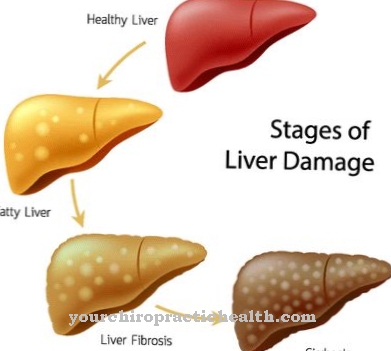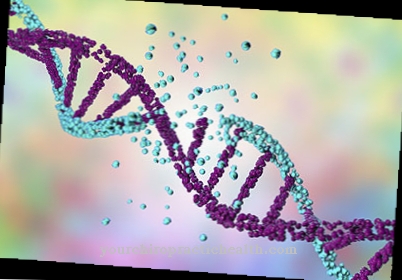At Disorders of the breasts it is a congenital malformation of the breast. The affected patients are mainly women, who mostly suffer significantly from their breast disorders. An operation is therefore advisable in particularly pronounced cases.
What are breast disorders?

© SENTELLO - stock.adobe.com
Disorders of the breasts are one of the diseases that in most cases are congenital. However, this malformation of the breast often only becomes clearly visible during puberty.
These disorders include, for example, breasts that are too small, too large or differently shaped. In addition, medicine knows other malformations such as missing or excess nipples or breast roots.
These disorders or malformations can already be recognized after birth. Most breast disorders affect women, but men can also have extra nipples, for example.
In general, these malformations of the breast are rare. In most cases, an increased health risk cannot be assumed, however, breast disorders are often very psychologically stressful for those affected.
causes
Little is known in medicine and science about the causes of breast disorders. Often, however, hormonal and genetic causes for this disease are discussed.
Depending on the type of malformation, the reason can be determined: Women with breasts that are too small often have too little breast tissue or a lack of the female hormones that are necessary and responsible for breast growth. Inflammatory diseases or breast injuries in childhood can also lead to breast disorders.
Symptoms, ailments & signs
System disorders exist from birth, but the first symptoms often only appear during puberty. Therefore, in some cases, the malformation of the breast is only noticed between the ages of 8 and 14. In both sexes, additional breasts or breasts of different sizes can grow during this period. Breasts that are too large or too small also occur during puberty, often associated with unusually severe growing pains or poor circulation in the affected area.
System disorders can affect both breasts or occur on one side. Underdeveloped or missing breasts are possible on one or both sides. Excess breasts usually appear on one side. Normally, there are no health problems in the case of breast disorders. However, back pain, neck pain, headaches, and migraines can be associated with some breast malformations.
Some sufferers develop a pronounced bad posture, which is usually also associated with pain. If the chest malformation is not treated, the cervical and thoracic spine can wear out. This manifests itself, among other things, through chronic pain and sensitivity disorders. With large breasts, skin infections can occur in the underbust fold. Many of those affected also develop emotional complaints and feel that their quality of life is restricted due to the disorder.
Diagnosis & course
Most breast disorders are only noticeable after the person concerned has entered puberty. Some malformations, such as additional breasts or nipples, can be diagnosed earlier, namely in infancy.
During the physical examination of the patient concerned, the consulting physician will first look at the attachment disorder and, if necessary, order a biopsy, i.e. the removal of a tissue sample, to determine the cause of the breast attachment disorder. If a hormone-related malformation is suspected, a blood count can provide information about the patient's hormone level.
If the malformation of the breast shows up immediately at birth, further examinations should definitely be initiated in the newborn. Breast disorders are often associated with other physical malformations such as the kidneys.
In most cases, however, the malformations of the breast are not or only slightly hazardous to health. For this reason, the doctor will often advise you to simply observe them in the case of breast disorders.
When should you go to the doctor?
Some breast disorders (e.g. additional breasts, excess nipples) can be identified immediately after the birth. The attending physician can then initiate treatment directly or suggest a later date to the parents of the child concerned.
Whether and when a doctor's visit is necessary depends, among other things, on the type and severity of the disorder and the constitution of the child. Usually only small changes such as bulges, slight cornification or hair islands are noticeable in the first years of life.
If these are benign, surgical treatment is not necessary. However, if symptoms such as pain, circulatory disorders or mental problems arise, a doctor must be consulted. Large breasts of different sizes or breasts that are too large on both sides should be treated solely because of the threat of back and neck pain.
System disorders such as small or sagging breasts should first be discussed with the gynecologist. The general rule is: as soon as the breast change is related to physical or psychological complaints, a surgical procedure makes sense.
Doctors & therapists in your area
Treatment & Therapy
Most breast disorders do not pose an increased health risk for those affected. However, many of the sick patients suffer from the cosmetic blemish, which can lead to enormous emotional stress.
If the person concerned suffers a great deal or even develops a mental disorder, there is the option of correcting these disorders of the breast with the help of cosmetic surgery if there are excess nipples or breast roots. This can alleviate the emotional suffering of the patient concerned.
With some disorders of the chest - especially with different sized or very heavy breasts - most affected patients suffer from severe pain in the back and cervical spine. In these cases there may be a physical impairment due to the disorders of the breast structure, so that the doctor may recommend an operation depending on the course of the disease.
If those affected suffer greatly from their deformed breast, psychosocial support or even psychotherapy is recommended. This can help those affected to accept their own body with the disorders of the breast and still feel good.
Outlook & forecast
The prognosis depends on the type of system disorder. It still depends on whether it can be expected to lead to symptoms later on. In most cases, at least in purely physiological terms, no disease value due to a disorder of the breast is to be expected, which is why the prognosis is purely medically favorable. This does not change anything in terms of possible cosmetic problems and the possible psychological stress on those affected.
The anisomastia, for example, allows long-term observation. Often the breasts converge as they grow, which reduces the need for surgery or the wearing of disguised rumblings and the like. The same applies to breasts that are perceived as too small. Whether they are perceived as annoying is an individual question. There are definitely women who can live with this situation, but the plastic-surgical route is open here.
Macromastia, on the other hand, can lead to pain and posture problems. Affected women can suffer physically and mentally as a result, which is why physiotherapy, detailed consultations or operations should be considered.
Serious system disorders, such as additional or missing breasts and nipples, have far more severe effects on those affected. While surplus can be corrected at an early stage through operations, missing attachments mean a correction with an implant, if this is desired.
This perceived incompleteness can lead to psychological stress in those affected. However, surgical scars and the need for special bras are also stressful for affected women. How the situation is perceived and what level of suffering arises must be considered in each individual case.
prevention
In most cases, breast disorders are congenital, which is why it is not possible to take preventive measures. However, since some of the malformations are hereditary, a newborn baby with an affected person in the family should always be examined very carefully in order to detect the disease early if necessary.
Aftercare
Whether aftercare is necessary depends on the severity of the system disorder. In many cases, there are no complaints at all, which is why patients do not even consider a visit to the doctor. It must also be noted that many genetic malformations are cosmetic in nature.
However, this results in psychological pressure that patients can overcome with the help of therapy. A doctor can prescribe a prescription for this. Plastic surgery can be performed to remove an attachment disorder to the breast. However, this is often not subsidized by the health insurance company. Massages often provide relief for chest pain.
Mainly a physical examination takes place to determine the system disorder. This is already possible after the birth. The doctor can arrange regular visits if complications are possible. If it is suspected that hormonal causes are causing the disease, a blood test is recommended. Those affected have a number of options for preventing symptoms themselves.
It is not uncommon for your help, apart from medical treatment, to ensure freedom from symptoms. For example, chest pain can be managed through strength training. Missing nipples can be reproduced with imitations and special bras. A choice of concealing clothing prevents the disease from being visible from the outside.
You can do that yourself
Sufferers of system disorders in the chest can take action apart from medical measures in order to decisively improve their quality of life and self-esteem.
To compensate for existing inequalities in the breasts (anisomastia), (silicone) inserts or appropriately adapted bras offer quick help for those affected. In this way, asymmetries perceived as unpleasant can be optically corrected. If the breast is too big or too small overall, bras can help with maximizing or minimizing effects. Choosing covering clothing can also help to make differences appear less noticeable. Flowing, loose and patterned fabrics help.
Pain that results from the size of the chest can be counteracted by strengthening the back muscles and appropriate support measures.
Missing nipples (athelia) can also be imitated by bras with appropriate attachments. Even if there are no breasts (amastia), silicone imitations are ideal.
Against sagging breasts as a consequence of a general weakness of the connective tissue (mastoptosis), appropriate and consistently performed sports exercises can bring about improvement. Strength exercises with dumbbells that train the chest area can achieve limited firmness. A well-fitting bra with wide straps and a strengthening underbust support gives the chest good support. Regular massages that stimulate blood circulation also strengthen the connective tissue.




.jpg)

.jpg)

















.jpg)



